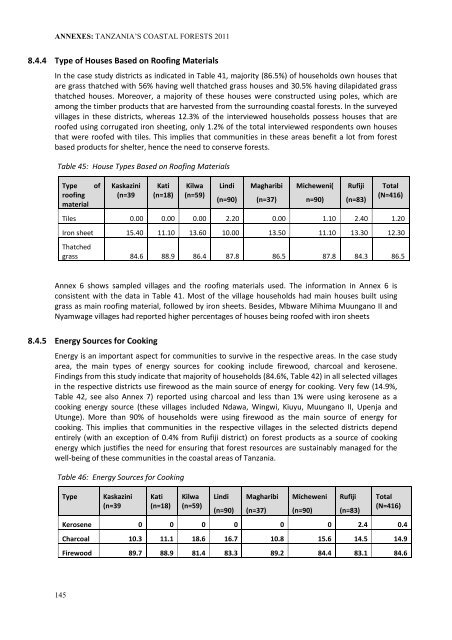Neil D. Burgess, Paul Harrison, Peter Sumbi, James Laizer, Adam ...
Neil D. Burgess, Paul Harrison, Peter Sumbi, James Laizer, Adam ...
Neil D. Burgess, Paul Harrison, Peter Sumbi, James Laizer, Adam ...
Create successful ePaper yourself
Turn your PDF publications into a flip-book with our unique Google optimized e-Paper software.
ANNEXES: TANZANIA’S COASTAL FORESTS 2011<br />
8.4.4 Type of Houses Based on Roofing Materials<br />
In the case study districts as indicated in Table 41, majority (86.5%) of households own houses that<br />
are grass thatched with 56% having well thatched grass houses and 30.5% having dilapidated grass<br />
thatched houses. Moreover, a majority of these houses were constructed using poles, which are<br />
among the timber products that are harvested from the surrounding coastal forests. In the surveyed<br />
villages in these districts, whereas 12.3% of the interviewed households possess houses that are<br />
roofed using corrugated iron sheeting, only 1.2% of the total interviewed respondents own houses<br />
that were roofed with tiles. This implies that communities in these areas benefit a lot from forest<br />
based products for shelter, hence the need to conserve forests.<br />
Table 45: House Types Based on Roofing Materials<br />
Type of<br />
roofing<br />
material<br />
Kaskazini<br />
(n=39<br />
Kati<br />
(n=18)<br />
Kilwa<br />
(n=59)<br />
Lindi<br />
(n=90)<br />
Magharibi<br />
(n=37)<br />
Micheweni(<br />
n=90)<br />
Rufiji<br />
(n=83)<br />
Total<br />
(N=416)<br />
Tiles 0.00 0.00 0.00 2.20 0.00 1.10 2.40 1.20<br />
Iron sheet 15.40 11.10 13.60 10.00 13.50 11.10 13.30 12.30<br />
Thatched<br />
grass 84.6 88.9 86.4 87.8 86.5 87.8 84.3 86.5<br />
Annex 6 shows sampled villages and the roofing materials used. The information in Annex 6 is<br />
consistent with the data in Table 41. Most of the village households had main houses built using<br />
grass as main roofing material, followed by iron sheets. Besides, Mbware Mihima Muungano II and<br />
Nyamwage villages had reported higher percentages of houses being roofed with iron sheets<br />
8.4.5 Energy Sources for Cooking<br />
Energy is an important aspect for communities to survive in the respective areas. In the case study<br />
area, the main types of energy sources for cooking include firewood, charcoal and kerosene.<br />
Findings from this study indicate that majority of households (84.6%, Table 42) in all selected villages<br />
in the respective districts use firewood as the main source of energy for cooking. Very few (14.9%,<br />
Table 42, see also Annex 7) reported using charcoal and less than 1% were using kerosene as a<br />
cooking energy source (these villages included Ndawa, Wingwi, Kiuyu, Muungano II, Upenja and<br />
Utunge). More than 90% of households were using firewood as the main source of energy for<br />
cooking. This implies that communities in the respective villages in the selected districts depend<br />
entirely (with an exception of 0.4% from Rufiji district) on forest products as a source of cooking<br />
energy which justifies the need for ensuring that forest resources are sustainably managed for the<br />
well-being of these communities in the coastal areas of Tanzania.<br />
Table 46: Energy Sources for Cooking<br />
Type<br />
Kaskazini<br />
(n=39<br />
Kati<br />
(n=18)<br />
Kilwa<br />
(n=59)<br />
Lindi<br />
(n=90)<br />
Magharibi<br />
(n=37)<br />
Micheweni<br />
(n=90)<br />
Rufiji<br />
(n=83)<br />
Total<br />
(N=416)<br />
Kerosene 0 0 0 0 0 0 2.4 0.4<br />
Charcoal 10.3 11.1 18.6 16.7 10.8 15.6 14.5 14.9<br />
Firewood 89.7 88.9 81.4 83.3 89.2 84.4 83.1 84.6<br />
145

















